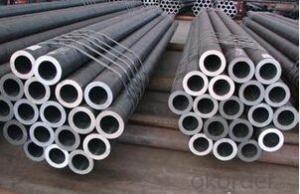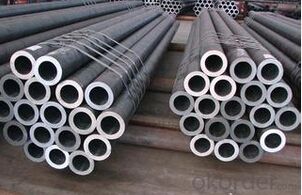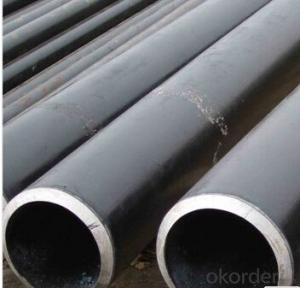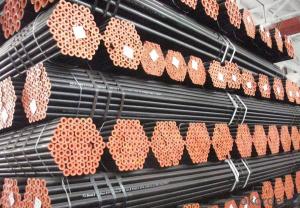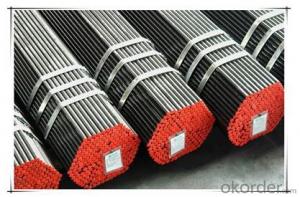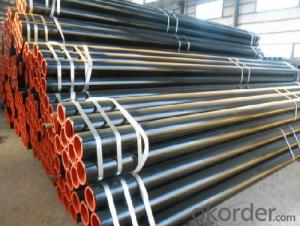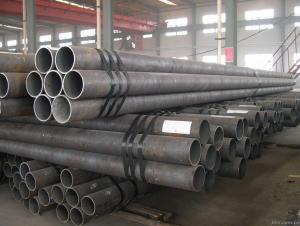Seamless Steel Pipe for low and medium pressure Boiler Tube
- Loading Port:
- Tianjin
- Payment Terms:
- TT or LC
- Min Order Qty:
- 1 m.t.
- Supply Capability:
- 10000 m.t./month
OKorder Service Pledge
OKorder Financial Service
You Might Also Like
Seamless Steel Pipe For Low and Medium Pressure Boiler
1)Size 1/2-24"
2) Material:ASTM A106 GRB/ A53 GRB/ API 5L GRB
Hot Seamless Steel Pipe For Low and Medium Pressure Boiler
Product Name | Seamless Carbon Steel Pipe |
Outside Diameter(mm) | 13.7mm-610mm |
Wall thickness(mm) | 2mm-60mm |
Certification | ISO:9000, API 5L, API 5CT |
Standard | 1.ASTM A106/A53 GR.A; ASTM A106/A53 GR.B; ASTM A53/A106 GR.C 2.APL 5L GR.B, API 5CT J55, K55, N80 3.DIN, JIS, BS, EN |
Grade | A, B, C, ST33, ST37, ST35.8, ST45-8, ST45-4, ST52 |
Face finished | 1.Manual polished 2.mechanical polished 3.black paint on the face 4.anti-rust oil and caps on both ends 5.galvanized |
Export | Europe, South America, the Middle East, Africa, Asia and other countries and regions, well received by consumers! |
Seamless theoretical weight | seamless calculation formula: (OD - Wall Thickness) × thickness × 0.02466 = Seamless weight per meter |
Process Method | 1.Cold Drawn 2.Cold rolled 3.Hot rolled 4. Hot expanded |
Application | Tube with hollow cross-section, a large number of channels for transporting fluids, such as the transportation of oil, natural gas, gas, water and some solid materials, pipes, etc.. |
Package | 1.Inner Packing:Caps at both ends, steel strong trips on every bundle 2.Outer Packing:Standard export package or as per clients' requirements |
- Q: What is the difference between carbon steel and stainless steel pipes?
- Carbon steel pipes are made primarily from carbon and iron and are known for their strength and durability. However, they are prone to corrosion over time. On the other hand, stainless steel pipes are made from a combination of iron, chromium, and nickel, which makes them highly resistant to corrosion. Stainless steel pipes are also known for their aesthetic appeal, as they have a sleek and shiny appearance. Overall, the main difference between carbon steel and stainless steel pipes lies in their corrosion resistance properties.
- Q: Can steel pipes be used for chemical refineries?
- Chemical refineries can utilize steel pipes for their operations. Steel pipes are frequently employed in chemical refineries because of their exceptional strength, long-lasting nature, and resistance to corrosion. Given the harsh conditions present in a chemical refinery, including exposure to corrosive chemicals and extreme temperatures, it is necessary to employ materials that can endure such circumstances. Steel pipes possess the capability to withstand these challenges and are often preferred for their ability to securely and efficiently transport diverse fluids and gases. Furthermore, the weldability of steel pipes permits easy installation and maintenance within intricate refinery systems. All in all, steel pipes are a fitting choice for chemical refineries due to their durability, ability to resist corrosion, and compatibility with the demanding conditions encountered in this industry.
- Q: How are steel pipes coated for protection?
- Steel pipes are commonly coated for protection through a process called galvanization. This involves immersing the pipes in a bath of molten zinc, creating a protective layer that prevents corrosion and extends their lifespan. Additionally, other methods such as epoxy coatings or polyethylene wrappings can be used to provide additional protection against external factors.
- Q: Are steel pipes suitable for use in coastal areas?
- Yes, steel pipes are suitable for use in coastal areas. Steel is highly resistant to corrosion and can withstand the harsh environmental conditions typically found in coastal regions, such as saltwater spray and high humidity. Additionally, steel pipes offer excellent structural strength, making them well-suited for various applications including marine construction, offshore oil and gas platforms, and coastal infrastructure projects.
- Q: How are steel pipes coated to prevent corrosion?
- Steel pipes are coated to prevent corrosion through a process called galvanization, where a layer of zinc is applied to the surface of the pipes. This zinc coating acts as a protective barrier, preventing the steel from coming into direct contact with moisture and other corrosive elements in the environment.
- Q: Can steel pipes be used for sewage treatment plants?
- Yes, steel pipes can be used for sewage treatment plants. Steel pipes are durable and resistant to corrosion, making them ideal for handling sewage and wastewater in such facilities. They are commonly used for conveying and distributing sewage, as well as for constructing various components like pipelines, pump stations, and treatment tanks. Additionally, steel pipes can withstand high pressure and are available in various sizes, making them suitable for the diverse needs of sewage treatment plants.
- Q: How do steel pipes handle seismic expansion joints?
- Steel pipes handle seismic expansion joints by incorporating flexible joints or bellows in the pipeline system. These flexible joints are designed to absorb and accommodate the movement caused by seismic activity, allowing the steel pipes to expand and contract without causing damage or failure to the overall pipeline system.
- Q: What is the importance of corrosion resistance in steel pipes?
- The importance of corrosion resistance in steel pipes is significant as it helps to extend the lifespan of the pipes, ensures their structural integrity, and maintains the quality of the fluid or gas being transported. Corrosion can lead to pipe failures, leaks, and contamination of the contents, resulting in costly repairs, environmental hazards, and potential safety risks. Therefore, incorporating corrosion-resistant properties in steel pipes is crucial for their long-term performance, durability, and overall efficiency.
- Q: What are the different types of flanges used with steel pipes?
- There are several types of flanges commonly used with steel pipes, including slip-on flanges, weld neck flanges, socket weld flanges, threaded flanges, blind flanges, and lap joint flanges. Each type has its own specific design and purpose, catering to different requirements such as ease of installation, high-pressure applications, or connecting different pipe sizes.
Send your message to us
Seamless Steel Pipe for low and medium pressure Boiler Tube
- Loading Port:
- Tianjin
- Payment Terms:
- TT or LC
- Min Order Qty:
- 1 m.t.
- Supply Capability:
- 10000 m.t./month
OKorder Service Pledge
OKorder Financial Service
Similar products
Hot products
Hot Searches
Related keywords
